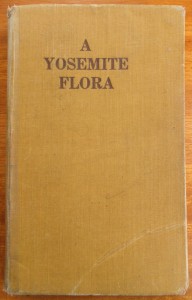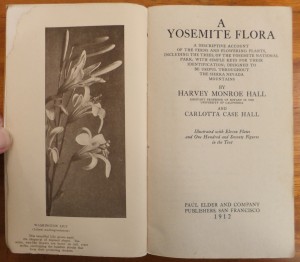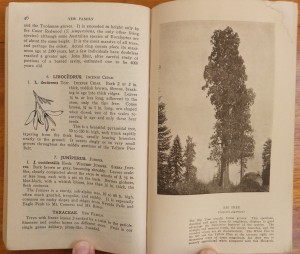
In 1912, the field guide was still a fairly new kind of book. The first modern field guide was Birds Through an Opera-Glass, written in 1890 by Florence August Merriam (1863-1948). The first botanical field guide in the United States was the 1893 How to Know the Wildflowers, by Mrs. William Starr Dana (Frances Theodora Parsons, 1861-1952). The public was clearly eager for these new field guides, as Parsons’s first printing sold out in five days, and she published several subsequent editions.
Harvey and Carlotta Hall’s 1912 field guide A Yosemite Flora is a work of the highest academic quality. Paul Elder published several “armchair nature” books, notably Bird Notes Afield by Charles Keeler, but this is the botany book that Keeler might well have carried in his back pocket while traipsing through the Sierras. It is profusely illustrated with 170 drawings and eleven plates (though due to a production error many copies were issued without plates 2-11, and contain an errata slip to that effect).

Harvey Monroe Hall (1874-1932) was born in Illinois but grew up in Riverside, California. He received his Ph.D. in botany in 1906 from the University of California, Berkeley, writing a thesis entitled The Compositae of Southern California. He remained on the UC faculty until 1919, when he joined the Carnegie Institute. There he began an exploration of experimental methods of plant taxonomy. In 1929 he came Acting Professor of Botany at Stanford University.
Hall was a painstaking investigator, and his work became the basis for a fresh approach to organic evolution. He had spent 1928 in Europe studying the national parks there, and his returned an enthusiastic proponent of a new model of ecological management, the wildlife preserve.

In 1910 Hall married Carlotta Case (1880-1949), a 1905 graduate of the University of California and a collector of western ferns. They had one daughter, Martha Hall Niccolls (1913-1991).
Shortly after Hall’s death, the Harvey Monroe Hall Research Natural Area was established within Inyo National Forest, just north of Tioga Pass in Yosemite National Park. It was one of the first RNAs to be created.